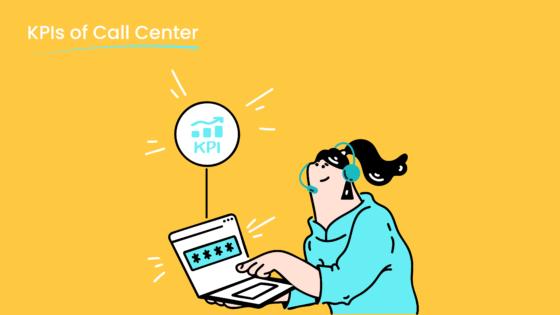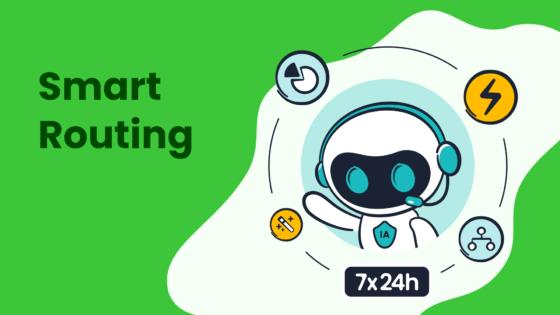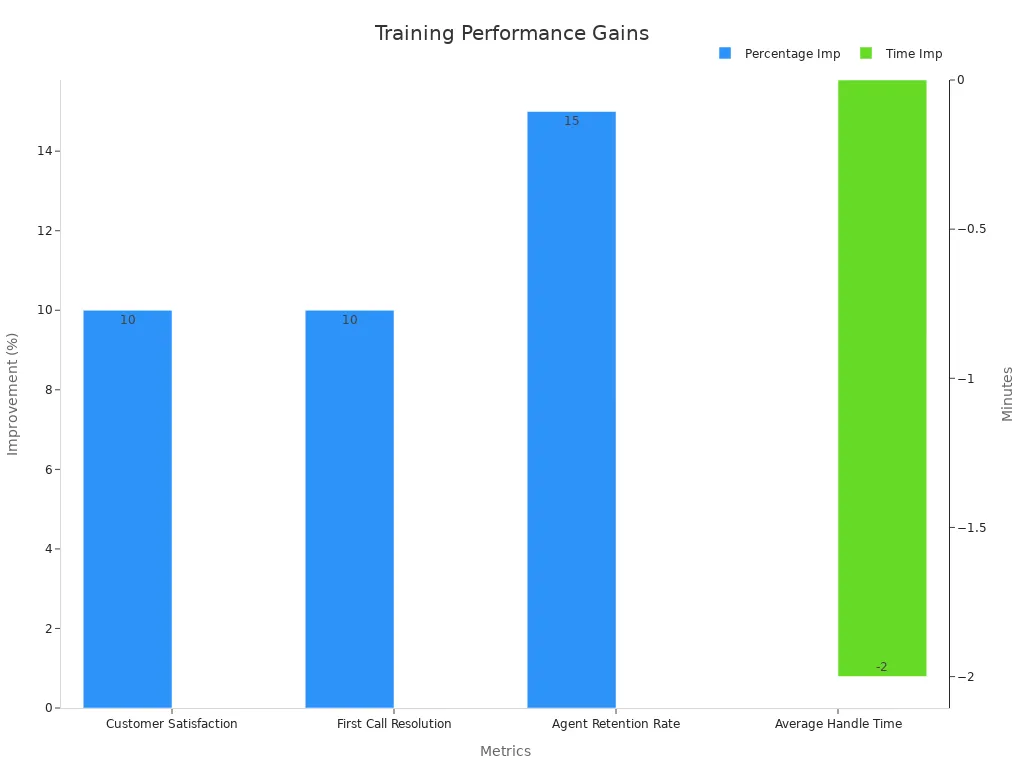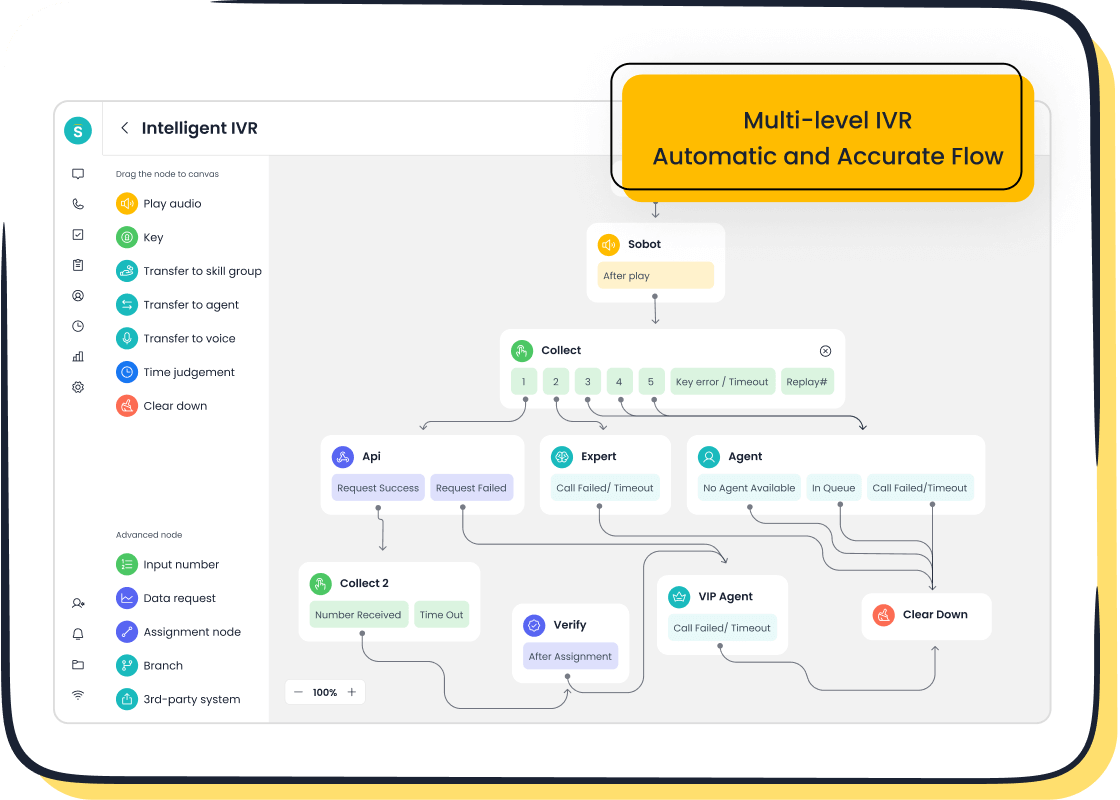How to Improve Agent Productivity with Contact Center Insights

Improving agent productivity in a call center starts with understanding their performance in real-time. Contact center monitoring plays a crucial role in identifying areas where agents can improve. It helps you boost efficiency and deliver better customer experiences. Tools like Sobot's Voice/Call Center provide actionable insights by analyzing call data. You can use these insights to enhance agent skills and optimize workflows. This approach not only improves agent performance but also ensures customer satisfaction with every interaction.
Understanding Agent Productivity in Contact Centers
What Is Agent Productivity?
Agent productivity refers to how effectively agents handle customer interactions and resolve issues within a given timeframe. It measures their ability to deliver quality service while maintaining efficiency. Productive agents can manage calls, emails, or chats swiftly without compromising customer satisfaction. This concept goes beyond speed; it includes the ability to provide accurate solutions and create positive experiences for customers.
When agents are productive, they can prevent an 8% revenue loss risk associated with poor customer experiences.
Why Agent Productivity Matters for Businesses and Agents
Agent productivity is crucial for both businesses and agents. For businesses, it directly impacts operational efficiency, costs, and customer satisfaction. High productivity ensures faster resolutions, fewer escalations, and improved customer loyalty. For agents, productivity fosters job satisfaction by reducing stress and burnout. Access to tools like AI assistants can enhance their performance, enabling them to resolve more issues per hour.
- Access to AI recommendations led to a 13.8% increase in the number of issues agents could resolve per hour.
- Less experienced agents saw a 35% improvement in resolutions per hour after using AI tools.
- Attrition rates among newer agents dropped by 40%, indicating higher job satisfaction.
Key Metrics to Measure Agent Productivity
Tracking performance metrics helps you evaluate agent productivity effectively. These metrics provide insights into efficiency, effectiveness, and customer satisfaction.
| KPI | Description |
|---|---|
| Average Handle Time (AHT) | Measures the average duration an agent spends on a call, indicating efficiency. |
| First Call Resolution (FCR) | Indicates the percentage of calls resolved on the first contact, reflecting effectiveness. |
| Customer Satisfaction (CSAT) | Gauges customer satisfaction levels, essential for assessing service quality. |
By monitoring these call center metrics, you can identify areas for improvement and optimize workflows to boost agent performance.
Challenges That Impact Agent Productivity
Common Barriers to Productivity in Contact Centers
Several obstacles can hinder call center productivity, affecting both agents and customer satisfaction. High call volumes often lead to longer wait times and increased call abandonment rates. When unresolved issues account for 20-30% of call volume, agents spend valuable time revisiting old problems instead of addressing new ones.
Disorganized software systems, especially after mergers, create communication barriers. Agents may struggle to locate customer information, slowing down resolution times. Additionally, insufficient automation in tools impacts efficiency. Research shows that 50% of managers lack adequate automation, leaving agents to handle repetitive tasks manually.
Other challenges include recruiting and retaining qualified staff. Poorly trained employees often fail to meet performance expectations, lowering overall productivity. High turnover rates further exacerbate this issue, as businesses must repeatedly invest in training new hires.
📊 Statistics Snapshot:
| Statistic | Description |
|-----------|-------------|
| 20-30% of call volume | Calls related to unresolved issues clog phone lines and consume agent time. |
| 50% of managers lack automation | Insufficient automation hinders efficiency and productivity. |
The Role of Stress and Burnout in Agent Performance
Stress and burnout significantly impact agent performance. Longer response times and frequent customer complaints often signal agent overwhelm. Monitoring stress indicators, such as changes in communication tone or consistent drops in feedback ratings, can help identify these challenges early.
Burnout detection models analyze call metrics to pinpoint stress levels. By offering timely well-being breaks, you can reduce the risk of burnout and improve overall performance. Refining workload strategies based on stress patterns also enhances agent productivity.
🔍 Tip: Pay attention to QA data and customer feedback. These insights reveal stress levels and help refine support strategies effectively.
Inefficient Tools and Processes
Legacy systems and outdated tools slow workflows, frustrating agents and reducing efficiency. Studies show that agents lose up to 30% of their time navigating between applications instead of addressing customer issues. Micro-delays from switching between tools accumulate, leading to significant productivity losses.
Investing in modern technology can resolve these inefficiencies. Intelligent call routing and integrated CRM systems streamline operations, allowing agents to focus on delivering quality service. These tools not only enhance productivity but also improve the overall customer experience.
🚀 Pro Tip: Upgrade to integrated systems like Sobot's Voice/Call Center to eliminate process inefficiencies and boost call center productivity.
Leveraging Contact Center Monitoring to Maximize Agent Productivity

Benefits of Real-Time Monitoring and Analysis
Real-time monitoring offers a powerful way to boost agent productivity. By analyzing live call data, you can identify trends, address issues immediately, and make informed decisions. This approach ensures that agents receive timely feedback, helping them improve their performance during active calls. Real-time analytics also allow you to monitor agent calls for quality assurance, ensuring consistent service delivery.
| Benefit | Explanation |
|---|---|
| More Reliable Data-Driven Insights | Decisions based on data reduce uncertainty and enhance trust in strategic initiatives. |
| Increased Accuracy | Predictive models minimize human error, leading to more precise forecasts and recommendations. |
| Faster Decision-Making | Real-time analytics enable quick responses to trends and operational issues, such as supply chain bottlenecks. |
| Personalization and Better Engagement | Tailoring products or services based on consumer data enhances customer loyalty and satisfaction. |
| Cost Reduction | Analytics help identify inefficiencies, allowing businesses to optimize resources and reduce costs. |
For example, real-time monitoring can help you detect when agents struggle with specific customer queries. You can then provide immediate coaching or route the call to a more experienced agent. This not only improves efficiency but also enhances customer satisfaction.
📊 Pro Tip: Use real-time monitoring to identify patterns in customer behavior. This insight can help you refine your workflows and maximize agent productivity.
How Sobot's Voice/Call Center Enhances Monitoring Capabilities

Sobot's Voice/Call Center takes monitoring to the next level by offering advanced tools for recording and monitoring calls. Its real-time analytics feature provides actionable insights that help you optimize agent performance. The platform enables you to track key metrics like average handle time and first call resolution, ensuring effective workforce management.
| Statistic/Case Study | Description |
|---|---|
| Inbound Volume Reduction | Over two years, the platform has reduced inbound discussion volume by 20% and increased positive feedback to 96%+. |
| Correct Answers Rate | With the help of Sobot's AI platform, over 80% of answers are correct, and over 95% of customers were satisfied. |
| Self-Service Rate | Sobot's solutions enable 22.2% of customers' questions to be answered independently, achieving a CSAT score of 97%. |
| Problem Resolution Rate | 85% of problems are solved with Sobot's solutions, leading to 99% customer satisfaction. |
| Sign-off and COD Collection Rates | The sign-off rate has increased by about 35%, and the COD collection rate has risen by about 40%. |
The platform’s unified workspace consolidates customer data, making it easier for agents to access relevant information during calls. This reduces the time spent searching for details, allowing agents to focus on resolving issues. Additionally, Sobot’s intelligent call routing ensures that customers are connected to the most suitable agent, further enhancing efficiency.
🚀 Did You Know? Sobot’s Voice/Call Center supports global telephony contacts and offers a 99.99% uptime, ensuring uninterrupted operations for your team.
Using Call Tracking to Identify Improvement Areas
Call tracking is a critical tool for identifying specific areas where agents can improve. By recording and monitoring calls, you can analyze key performance indicators (KPIs) such as call resolution rates and customer satisfaction scores. This data helps you pinpoint weaknesses and implement targeted training programs.
| Evidence Type | Description |
|---|---|
| KPI Tracking | Call analytics track KPIs like call resolution rates and customer satisfaction scores, helping identify areas for agent improvement. |
| Real-time Feedback | Supervisors can provide immediate coaching based on live call assessments, enhancing agent performance through instant guidance. |
| Data Consistency | Regular monitoring of established KPIs allows organizations to identify trends and areas needing improvement, enriching the analysis with both qualitative and quantitative data. |
For instance, if call tracking reveals that agents struggle with resolving technical issues, you can update your centralized knowledge base to include more detailed troubleshooting guides. This ensures agents have the resources they need to handle similar queries in the future.
🔍 Tip: Use call tracking to monitor agent calls and identify recurring customer pain points. This insight can help you refine your training programs and boost agent productivity.
Actionable Strategies to Improve Call Center Agent Performance

Implementing AI-Powered Tools for Real-Time Assistance
AI-powered tools have revolutionized how you can improve call center agent performance. These tools provide real-time assistance, enabling agents to handle customer inquiries more effectively. For example, AI-driven systems can suggest solutions during live calls, reducing response times and enhancing accuracy. This empowers agents to focus on delivering personalized service while maintaining high productivity.
- Customer satisfaction increases by 64% in call centers that offer real-time assistance.
- 90% of customers prioritize quick issue resolution when contacting support.
- Businesses using AI agents report a 12% improvement in customer satisfaction.
Sobot's Voice/Call Center integrates AI-powered voicebots that recognize customer intent and provide intelligent suggestions. These features allow agents to resolve issues faster, boosting both efficiency and customer satisfaction. By adopting such tools, you can ensure your agents have the autonomy to make informed decisions during calls, fostering a more productive work environment.
💡 Tip: Use AI tools to provide agents with instant access to customer data and recommended actions. This reduces the need for escalations and improves first-call resolution rates.
Providing Comprehensive Training and Skill Development
Agent training is a cornerstone of improving call center performance. Comprehensive programs equip agents with the skills needed to handle diverse customer scenarios. Training sessions should focus on both technical knowledge and soft skills, such as empathy and active listening.
| Metric | Before Training | After Training | Improvement |
|---|---|---|---|
| Customer Satisfaction | 75% | 85% | +10% |
| Average Handle Time | 8 minutes | 6 minutes | -2 minutes |
| First Call Resolution | 70% | 80% | +10% |
| Agent Retention Rate | 60% | 75% | +15% |

Sobot's unified workspace simplifies agent training by consolidating customer data and communication tools into one platform. This reduces the learning curve for new hires and enhances agent autonomy. With access to real-time analytics and call tracking, agents can continuously refine their skills, ensuring they stay ahead of customer expectations.
🔍 Note: Regularly update your training programs to include the latest tools and techniques. This keeps your team prepared for evolving customer needs.
Intelligent Routing to Match Agents with Customer Needs
Intelligent routing ensures that customers connect with the right agent based on their specific needs. This strategy improves call center efficiency by reducing wait times and enhancing the overall customer experience.
- Customers connect with the right expert immediately, reducing frustration.
- Agents handle inquiries that match their skills, leading to quicker resolutions.
- The system learns over time, providing insights into customer needs and communication patterns.

Sobot's Voice/Call Center offers smart call routing, which automatically directs calls to the most suitable agent. This feature not only improves agent productivity but also enhances customer satisfaction by ensuring faster and more accurate resolutions. For instance, if a customer has a technical issue, the system routes the call to an agent with expertise in that area.
🚀 Pro Tip: Use intelligent routing to balance workloads among agents. This prevents burnout and ensures consistent service quality.
Fostering a Positive Work Environment and Recognition Culture
Creating a positive work environment and fostering a culture of recognition can transform your contact center into a hub of productivity and satisfaction. When agents feel valued, their motivation increases, leading to better performance and higher customer satisfaction. You can achieve this by implementing strategies that prioritize engagement and acknowledgment.
Why a Positive Work Environment Matters
A supportive work environment reduces stress and burnout, which are common challenges in contact centers. Agents who feel supported are more likely to stay focused and deliver exceptional service. Studies show that workplaces emphasizing recognition see improvements in key metrics like First Call Resolution (FCR), Average Handle Time (AHT), and Customer Satisfaction (CSAT).
📊 Fact: Higher FCR rates and reduced AHT have been observed in contact centers that regularly recognize agent efforts.
Strategies to Build a Recognition Culture
- Celebrate Milestones: Recognize agents for achieving goals like resolving a high number of calls or maintaining excellent CSAT scores.
- Offer Incentives: Provide rewards such as gift cards or extra time off for outstanding performance.
- Public Acknowledgment: Highlight achievements during team meetings or through internal communication channels.
- Feedback Integration: Use customer feedback to identify agents who consistently deliver great service and celebrate their contributions.
These initiatives not only enhance engagement but also create a sense of belonging among your team.
How Sobot Supports Agent Engagement
Sobot’s Voice/Call Center helps you foster a positive work environment by providing tools that simplify workflows and reduce stress. Its unified workspace consolidates customer data, allowing agents to focus on delivering quality service without juggling multiple systems. The platform’s real-time monitoring and analytics enable you to track performance metrics like FCR and CSAT, making it easier to identify and reward top-performing agents.
For example, if an agent consistently achieves high FCR rates, you can use Sobot’s analytics to highlight their success and provide recognition. This approach not only motivates the agent but also sets a benchmark for others to follow.
The Impact of Recognition on Engagement
Recognition initiatives directly enhance engagement by making agents feel valued. When agents know their efforts are appreciated, they become more invested in their roles. This leads to measurable improvements in performance metrics:
- Reduced AHT as agents work more efficiently.
- Higher FCR rates due to increased focus and motivation.
- Improved CSAT scores as agents deliver better customer experiences.
💡 Tip: Regularly review performance metrics to identify opportunities for recognition. This keeps your team motivated and engaged.
By fostering a positive work environment and recognition culture, you can create a thriving contact center where agents excel and customers leave satisfied.
Best Practices for Improving Call Center Productivity
Establishing Feedback Loops Between Agents and Managers
Creating effective feedback loops between agents and managers is essential for improving call center productivity. Clear communication channels allow both parties to exchange ideas and address performance gaps. Regular feedback sessions encourage open discussions about strengths and areas for improvement. These sessions foster accountability and help agents view feedback as opportunities rather than criticisms.
- Establish communication channels to ensure feedback flows in both directions.
- Conduct regular sessions to discuss performance and improvement opportunities.
- Promote a proactive culture where agents actively seek customer feedback.
When you prioritize constructive feedback, agents feel supported and motivated to enhance their skills. This approach builds trust and creates a collaborative environment that drives better results.
💡 Tip: Use customer feedback to identify patterns and refine your coaching strategies. This helps agents deliver consistent service and improve call center productivity.
Integrating Monitoring Tools Seamlessly into Daily Operations
Monitoring tools play a vital role in tracking agent performance and ensuring consistent service quality. Integrating these tools into daily operations allows you to analyze call data efficiently and make informed decisions. Real-time monitoring enables supervisors to intervene during calls, improving customer satisfaction. Automated tools simplify the process by offering actionable insights with minimal effort.
- Listen to calls and conduct quality assurance to understand customer experiences.
- Use real-time monitoring to address issues during active calls.
- Analyze call data with automated tools to identify trends and optimize workflows.
- Quality Assurance evaluates call quality and adherence to standards.
- Performance Monitoring tracks agent productivity and key metrics.
- Speech Analytics extracts insights from call recordings to understand customer sentiment.

By integrating monitoring tools like Sobot’s Voice/Call Center, you can streamline operations and improve call center productivity. These tools provide real-time analytics and unified workspaces, making it easier for agents to access customer information and resolve issues efficiently.
🚀 Pro Tip: Leverage monitoring tools to identify recurring challenges and implement targeted solutions. This ensures continuous improvement in service delivery.
Using Data-Driven Insights for Continuous Improvement
Data-driven insights are crucial for enhancing call center operations. Predictive tools analyze historical data to anticipate trends and improve service quality. Real-time performance monitoring helps you identify issues as they arise, enabling quick adjustments. Tailored feedback based on data ensures agents receive relevant coaching to refine their skills.
- Predictive tools analyze past data to forecast future trends.
- Real-time monitoring identifies issues and allows immediate intervention.
- Insights into customer preferences enable personalized service delivery.
Integrated analytics tools enhance operational efficiency by capturing real-time data on agent performance and customer behavior. Continuous analysis of customer interactions helps you adapt to changing needs and improve quality assurance practices.
📊 Fact: Businesses using data-driven strategies report higher customer satisfaction scores and improved agent productivity.
By using data effectively, you can refine workflows, train agents more effectively, and deliver exceptional customer experiences. This approach ensures your call center remains agile and responsive to evolving demands.
Leveraging Sobot's Unified Workspace for Enhanced Efficiency
Sobot’s Unified Workspace transforms how agents manage customer interactions. It consolidates all essential tools and data into one platform, eliminating the need to switch between multiple systems. This streamlined approach boosts efficiency and reduces errors, allowing agents to focus on delivering exceptional service.
Why Unified Workspaces Matter
Fragmented systems slow agents down. Studies show that agents lose up to 30% of their time navigating between applications. This inefficiency impacts productivity and customer satisfaction. A unified workspace solves this problem by centralizing customer information, communication tools, and analytics.
💡 Did You Know? Agents using unified workspaces resolve issues 25% faster and achieve higher customer satisfaction scores.
Key Features of Sobot’s Unified Workspace
Sobot’s Unified Workspace offers advanced features designed to enhance agent productivity:
- Centralized Customer Data: Access customer profiles, interaction history, and preferences in one place.
- Integrated Communication Tools: Manage calls, emails, and chats without switching platforms.
- Real-Time Analytics: Monitor performance metrics like Average Handle Time (AHT) and First Call Resolution (FCR).
- AI-Powered Assistance: Receive intelligent recommendations during live interactions.
These features empower agents to handle inquiries efficiently, reducing Average Handle Time by up to 20%.
Real-World Impact
Companies like OPPO have leveraged Sobot’s Unified Workspace to improve service quality. By integrating customer data and communication channels, OPPO reduced agent workload and increased customer satisfaction rates to 94%.
📊 Fact: Businesses using Sobot’s Unified Workspace report a 30% improvement in operational efficiency.

Sobot’s Unified Workspace simplifies workflows, enhances agent productivity, and ensures consistent service delivery. Explore how this tool can transform your contact center operations by visiting Sobot’s Voice/Call Center.
Measuring Success and Driving Continuous Improvement
Tracking Key Performance Indicators (KPIs)
Tracking key performance indicators (KPIs) helps you measure the success of your contact center. These metrics provide a clear picture of how well your team is performing and where improvements are needed. By focusing on KPIs, you can ensure that your agents deliver quality service while maintaining efficiency.
| KPI | Description | Impact on Success |
|---|---|---|
| Customer Satisfaction (CSAT) | Measures customer satisfaction with service. | High CSAT correlates with client loyalty; 68% of clients leave due to poor service. |
| First Interaction Resolution (FCR) | Percentage of inquiries resolved on the first contact. | High FCR indicates effective problem-solving, enhancing customer satisfaction. |
| Average Handle Time (AHT) | Average duration of customer interactions. | Balancing AHT with service quality is crucial; focusing solely on AHT can harm satisfaction. |
| Net Promoter Score (NPS) | Evaluates customer loyalty and likelihood to recommend. | Strong NPS is linked to higher revenue growth and better client retention. |
| Service Level | Percentage of inquiries answered within a set time. | 78% of clients prioritize quick resolution, making this a key factor in overall satisfaction. |
Monitoring these KPIs allows you to identify trends and adjust strategies to improve both agent productivity and customer satisfaction.
📊 Tip: Use tools like Sobot’s Voice/Call Center to track KPIs in real-time and make data-driven decisions.
Regularly Reviewing and Adjusting Strategies
Regular reviews of your contact center strategies ensure that your operations stay aligned with customer needs. By analyzing performance data, you can identify pain points and make necessary adjustments. This practice improves customer satisfaction and operational efficiency.
| Evidence Category | Findings |
|---|---|
| Improved customer satisfaction | Analytics highlight customer pain points through feedback patterns, enhancing experiences. |
| Enhanced operational efficiency | Tools predict call peaks, optimizing agent scheduling and resource allocation. |
| Data-driven decision-making | Insights guide strategy modifications, making adjustments more informed and effective. |
For example, if analytics reveal a spike in call volume during specific hours, you can adjust agent schedules to handle the demand. This proactive approach ensures smoother operations and happier customers.
🔍 Pro Tip: Schedule regular strategy reviews to stay ahead of customer expectations and market trends.
Encouraging Agent Participation in Productivity Initiatives
Involving agents in productivity initiatives fosters a sense of ownership and motivates them to perform better. Open communication during feedback sessions allows agents to share challenges and suggest solutions. This creates a supportive environment where everyone works toward common goals.
- Open communication during feedback sessions helps agents feel comfortable discussing challenges.
- Actionable steps tailored for each agent allow them to track their improvement.
- Regular feedback sessions empower agents by highlighting strengths and addressing growth areas.
- Assessing performance metrics ensures targeted improvement strategies.
- Recognizing individual and team achievements boosts morale and encourages continuous improvement.
When agents feel valued and engaged, they contribute more effectively to the team’s success. Recognizing their efforts and celebrating milestones further enhances their motivation.
💡 Tip: Use Sobot’s analytics to identify top-performing agents and reward their contributions. This builds a culture of recognition and continuous improvement.
Contact center monitoring transforms agent productivity by providing actionable insights that improve performance and ensure high levels of customer satisfaction. Tools like Sobot's Voice/Call Center simplify workflows, reduce inefficiencies, and enhance service quality. For example, advanced analytics and AI-powered communication tools enable agents to deliver accurate and timely responses, fostering better customer experiences.
By adopting strategies such as intelligent routing, real-time monitoring, and unified workspaces, you can create a more efficient contact center. These approaches not only boost agent morale but also reduce operational costs. Organizations that implement monitoring solutions often see measurable improvements, such as higher first-contact resolution rates and reduced handling times.
Take the next step to optimize your contact center operations. Leverage Sobot’s innovative solutions to empower your agents and achieve consistent productivity gains.
FAQ
What is the best way to measure agent productivity in a contact center?
You can measure productivity by tracking key performance indicators (KPIs) like Average Handle Time (AHT), First Call Resolution (FCR), and Customer Satisfaction (CSAT). These metrics provide insights into efficiency, effectiveness, and service quality.
How can real-time monitoring improve agent productivity?
Real-time monitoring helps you identify issues as they occur. It allows you to provide immediate feedback and support to agents. This ensures they stay on track and deliver consistent service, improving overall productivity.
What tools can help agents handle customer interactions more efficiently?
AI-powered tools, unified workspaces, and intelligent call routing systems streamline workflows. These tools reduce the time agents spend on repetitive tasks and help them focus on resolving customer issues effectively.
How does stress affect agent productivity?
Stress reduces focus and increases errors. It can lead to longer response times and lower customer satisfaction. Monitoring stress indicators and offering support can help agents maintain high productivity levels.
Why is training important for improving agent productivity?
Training equips agents with the skills they need to handle diverse customer scenarios. It improves their confidence and efficiency, leading to faster resolutions and better customer experiences.
See Also
Enhancing Call Center Efficiency Through Effective Monitoring Strategies
Effective Strategies for Managing Live Chat Support Teams
Best AI Solutions for Enhancing Enterprise Contact Centers
